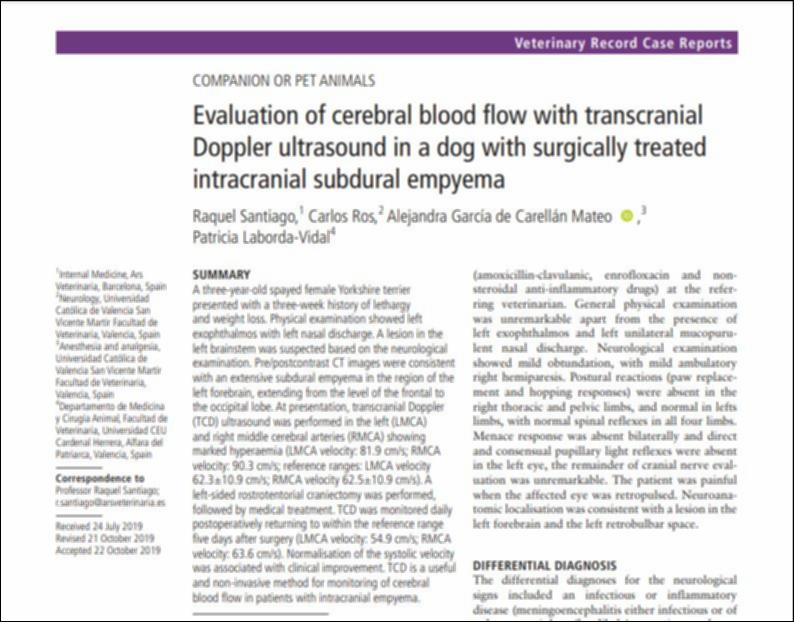Por favor, use este identificador para citar o enlazar este ítem:
http://hdl.handle.net/10637/15414Evaluation of cerebral blood flow with transcranial Doppler ultrasound in a dog with surgically treated intracranial subdural empyema

Ver/Abrir:
Evaluation_Santiago_VRCR_2019.JPG
127,57 kB
JPEG
Ver/Abrir:
Evaluation_Santiago_VRCR_2019.pdf
Acceso restringido
249,2 kB
Adobe PDF
Request a copy
| Título : | Evaluation of cerebral blood flow with transcranial Doppler ultrasound in a dog with surgically treated intracranial subdural empyema |
| Autor : | Santiago, Raquel Ros, Carlos García de Carellán Mateo, Alejandra Laborda Vidal, Patricia |
| Materias: | Diagnóstico por ultrasonidos; Diagnostic ultrasonic imaging; Tratamiento médico; Medical treatment; Circulación cerebral; Cerebral circulation; Sistema nervioso; Nervous systems; Ecografía en veterinaria; Veterinary ultrasonography |
| Editorial : | John Wiley & Sons |
| Citación : | Santiago, R., Ros, C., García de Carellán Mateo, A. & Laborda-Vidal, P. (2019). Evaluation of cerebral blood flow with transcranial Doppler ultrasound in a dog with surgically treated intracranial subdural empyema. Veterinary Record Case Reports, vol. 7, i. 4, art. e000935 (dec.). DOI: https://doi.org/10.1136/vetreccr-2019-000935 |
| Resumen : | A three- year- old spayed female Yorkshire terrier presented with a three- week history of lethargy and weight loss. physical examination showed left exophthalmos with left nasal discharge. a lesion in the left brainstem was suspected based on the neurological examination. pre/postcontrast Ct images were consistent with an extensive subdural empyema in the region of the left forebrain, extending from the level of the frontal to the occipital lobe. at presentation, transcranial Doppler (tCD) ultrasound was performed in the left (lmCa) and right middle cerebral arteries (RmCa) showing marked hyperaemia (lmCa velocity: 81.9 cm/s; RmCa velocity: 90.3 cm/s; reference ranges: lmCa velocity 62.3±10.9 cm/s; RmCa velocity 62.5±10.9 cm/s). a left- sided rostrotentorial craniectomy was performed, followed by medical treatment. tCD was monitored daily postoperatively returning to within the reference range ive days after surgery (lmCa velocity: 54.9 cm/s; RmCa velocity: 63.6 cm/s). normalisation of the systolic velocity was associated with clinical improvement. tCD is a useful and non- invasive method for monitoring of cerebral blood low in patients with intracranial empyema. |
| Descripción : | Este recurso no está disponible en acceso abierto por política de la editorial. |
| URI : | http://hdl.handle.net/10637/15414 |
| ISSN : | 2052-6121 |
| Fecha de publicación : | dic-2019 |
| Centro : | Universidad Cardenal Herrera-CEU |
| Aparece en las colecciones: | Dpto. Medicina y Cirugía Animal |
Los ítems de DSpace están protegidos por copyright, con todos los derechos reservados, a menos que se indique lo contrario.

